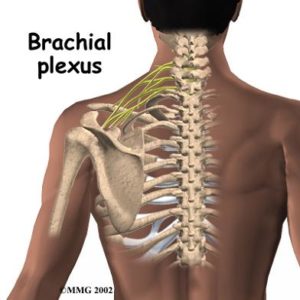 As you begin to read this article mentally check out your shoulders. Are one or both elevated toward your ears? If so, release them. Push the outside tops of the shoulder blades down and back while moving the bottom tips in and towards each other. This movement will facilitate an opening in the chest. Find that opening. This is the best position for the scapula bones (aka shoulder blades). And it makes a difference.
As you begin to read this article mentally check out your shoulders. Are one or both elevated toward your ears? If so, release them. Push the outside tops of the shoulder blades down and back while moving the bottom tips in and towards each other. This movement will facilitate an opening in the chest. Find that opening. This is the best position for the scapula bones (aka shoulder blades). And it makes a difference.
Perhaps the most important factor, with far reaching consequences, is the effect that the scapula placement has on the brachial plexus. The brachial plexus is a network of nerves starting at the upper vertebrae and going thru to the hand on each side of the body. These nerves run from the spine, through the plexus, down into the arm as well as up into the neck and head. When the shoulders are habitually elevated, the scapula puts pressure on the brachial plexus, leading to tension in the spine and possible nerve impingement. As the brachial plexus is an epicenter of the neurological communication to the head, neck and arms, this is a recipe for disaster for those areas. This is how it works:
When it comes to the scapula bone a little movement in one direction creates a lot of movement in the other direction. So, when we elevate the tops of shoulders even a little bit, the bone will also move towards the midline. That’s the nature of the scapula. And when the scapula bones move toward the midline they compress the brachial plexus nerves.
The issue is that nerves, ligaments, vertebrae and vertebral disks don’t respond well to constant compression. The nerves tend to get hypertonic, which means they get over-reactive and the muscles tend to get hyper-contractive or over-contracted. So now you have tense muscles and nerves alongside vulnerable vertebrae and disk all within the small area between the neck and shoulder blades where 100% of the nerve enervation for the shoulder, arm and hand resides.
Headaches, neck tension, radiating pain down the arm, and anything related to the elbow, hand, fingers, wrist and all carpal tunnel symptoms find a path to their discomforts through the brachial plexus, and thus, through the scapula bones.
I have been working with patients for 30 years and over the past decade I’ve seen a significant rise in cases with brachial plexus  impingement. It is my belief that the root cause of this increase is our growing use of computers, cell phones and other hand held electronic devices. You see, one of the byproducts of using all the technology is that it encourages us to elevate our shoulders. Without realizing it, we are taking this hard bone and pushing it in toward the spinal cord all the time.
impingement. It is my belief that the root cause of this increase is our growing use of computers, cell phones and other hand held electronic devices. You see, one of the byproducts of using all the technology is that it encourages us to elevate our shoulders. Without realizing it, we are taking this hard bone and pushing it in toward the spinal cord all the time.
This elevated scapula bone is affecting young people at a concerning rate. At Dorfman Kinesiology we see many Jr. High and High School students who come to us with symptoms indicative of compression in the brachial plexus. Headaches and neck tension are common. And most of these students experience a lot of stress. Stress is a byproduct of the tension on the nerves. It can create a negative feedback loop with more tension creating more stress, which creates more tension.
Luckily we have the solution: Keep your shoulders down. Notice when they rise up and pull them down again. This body awareness is key to resolving brachial plexus tension. You are an active participant in your own health care. This is something that can only be resolved with your involvement and care.
Self-massage and stretching are other key components of any strategy to alleviate brachial plexus issues. In the next article I will detail specific ways to use these self-care techniques to address the brachial plexus. In the meantime, maintain your awareness, keep your shoulders down and you will begin to feel better forever.
___________________
